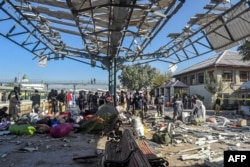Scores of multimillion-dollar Chinese-funded development projects dot South and Central Asia.
But rising violence is threatening to derail China's investments in the region, which is key to Beijing's global Belt and Road Initiative (BRI).
In Pakistan, militants have killed seven Chinese workers so far this year. In Tajikistan, a Chinese worker was killed this month in the first attack of its kind.
The killing of Chinese nationals has highlighted the growing fighting capabilities of extremist groups in the region, which has long been a hotbed of militancy.
'The Chinese Are So Frustrated'
Thousands of Chinese nationals work in Pakistan, which is home to the $60 billion China-Pakistan Economic Corridor (CPEC), an integral part of the BRI.
To protect Chinese workers, Islamabad has created a special police force, installed hundreds of checkpoints, and erected numerous barriers around the megaprojects. But the measures have failed to curb the rising number of attacks on Chinese workers in recent years.
Experts have put that down largely to Pakistani security and intelligence lapses as well as the increasing capabilities of the Baloch Liberation Army, the largest armed group in the southwestern province of Balochistan.
"China believes in safe investments, meaning they do not like conflicts around their projects," said Jalal Bazwan, a researcher at China's Zhejiang University.
"The Chinese are so frustrated because of the inability of the Pakistan government to provide security that they will not invest in further projects," he added.
Balochistan, an impoverished but energy-rich region, is the site of dozens of Chinese-funded infrastructure, energy, and trade projects. The vast province borders Afghanistan and Iran and is home to Pakistan's Baluch ethnic minority, who accuse Islamabad of exploiting the province's natural wealth.
In October, the BLA killed two Chinese citizens in a bombing outside the airport in Pakistan's largest city, Karachi. In March, a suicide bomber drove an explosives-laden car into a bus carrying Chinese workers in northwestern Pakistan, killing five of them. No group claimed responsibility.
The fighting capabilities of the BLA, a separatist militant group, have increased in recent years.
Estimated to have around 5,000 fighters, the BLA has been boosted by the influx of U.S. weapons to Pakistan since the Taliban takeover of neighboring Afghanistan in 2021.
The BLA has also evolved in recent years, adopting tactics used by militant Islamist groups like suicide bombings. The BLA has also boosted its ranks by recruiting women.
Besides attacking Chinese nationals, the BLA has also rapidly increased its attacks on Pakistani security forces.
"Generous donations, tax and extortion of local projects, and the purchase of modern weapons have helped the BLA carry out more attacks with precision," said Bahot Baloch, a researcher on armed groups in Balochistan.
Experts say China is concerned that rising violence in Balochistan could disrupt its projects in Pakistan.
In a sign of Beijing's worries, China said on November 19 that it will send troops to Pakistan later this month for their first joint counterterrorism military exercise in five years.
Pakistan on November 19 announced plans to launch a new military offensive against militants in Balochistan.
"No doubt that the attacks have increased," said Abdullah Khan, managing director of the Pakistan Institute of Conflict and Security Studies think tank. "However, this will not deter China or make it wind down its projects and leave Pakistan. The billion-dollars investment is too big to pause. China is here to stay."
First Known Attack In Tajikistan
On November 18, one Chinese national was killed and four injured in a cross-border attack in Tajikistan's south, sources told RFE/RL's Tajik Service.
The sources said the attackers crossed from Afghanistan. But it was unclear if they were criminals possibly involved in drug trafficking, a crime that is common in the area, or members of a militant group.
The Chinese nationals were reportedly working at a gold mine in the Zarbuzi Gorge.
Significantly, the attack marked the first known incident resulting in the death of a Chinese national in Tajikistan, home to major Chinese-funded energy and transport projects.
The deadly attack underscored the persistent security concerns along Tajikistan's southern frontier. Dozens of extremist groups are active inside Afghanistan, including the Islamic State-Khorasan (IS-K), the Islamic Movement of Uzbekistan (IMU), and Jamaat Ansarullah, which is comprised mainly of Tajik citizens.
Edward Lemon, a Central Asia expert at Texas A&M University, says China has long been concerned over the security of its operations in Tajikistan and it has invested significantly in bolstering the Tajik military and law enforcement.
"Rather than derailing China's investments in the country, I think this attack will only strengthen China's role in security in the country," he said. "We can expect further military aid, training, and potentially an expanded role for Chinese private security companies operating in the country to protect Chinese investments."












